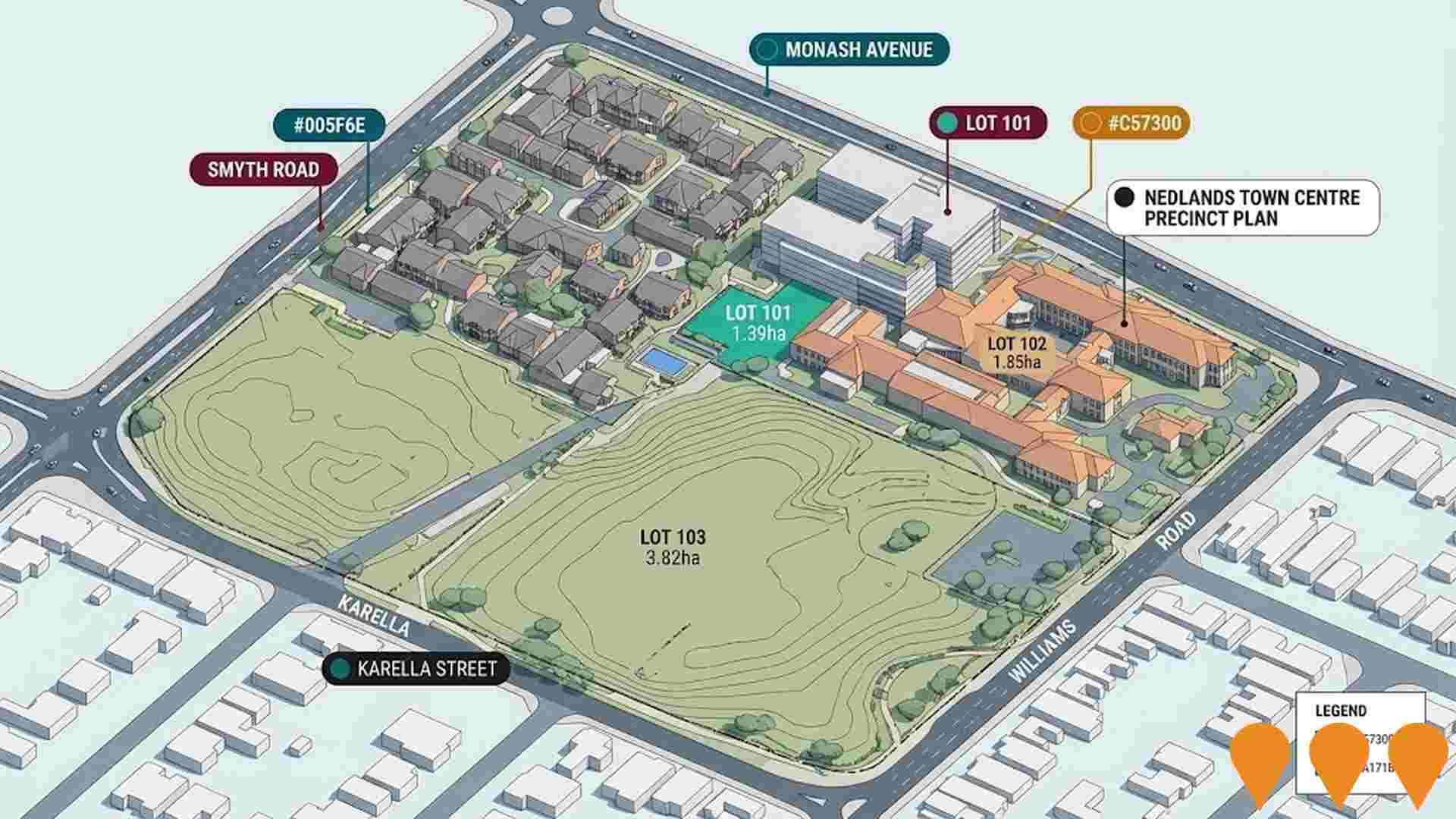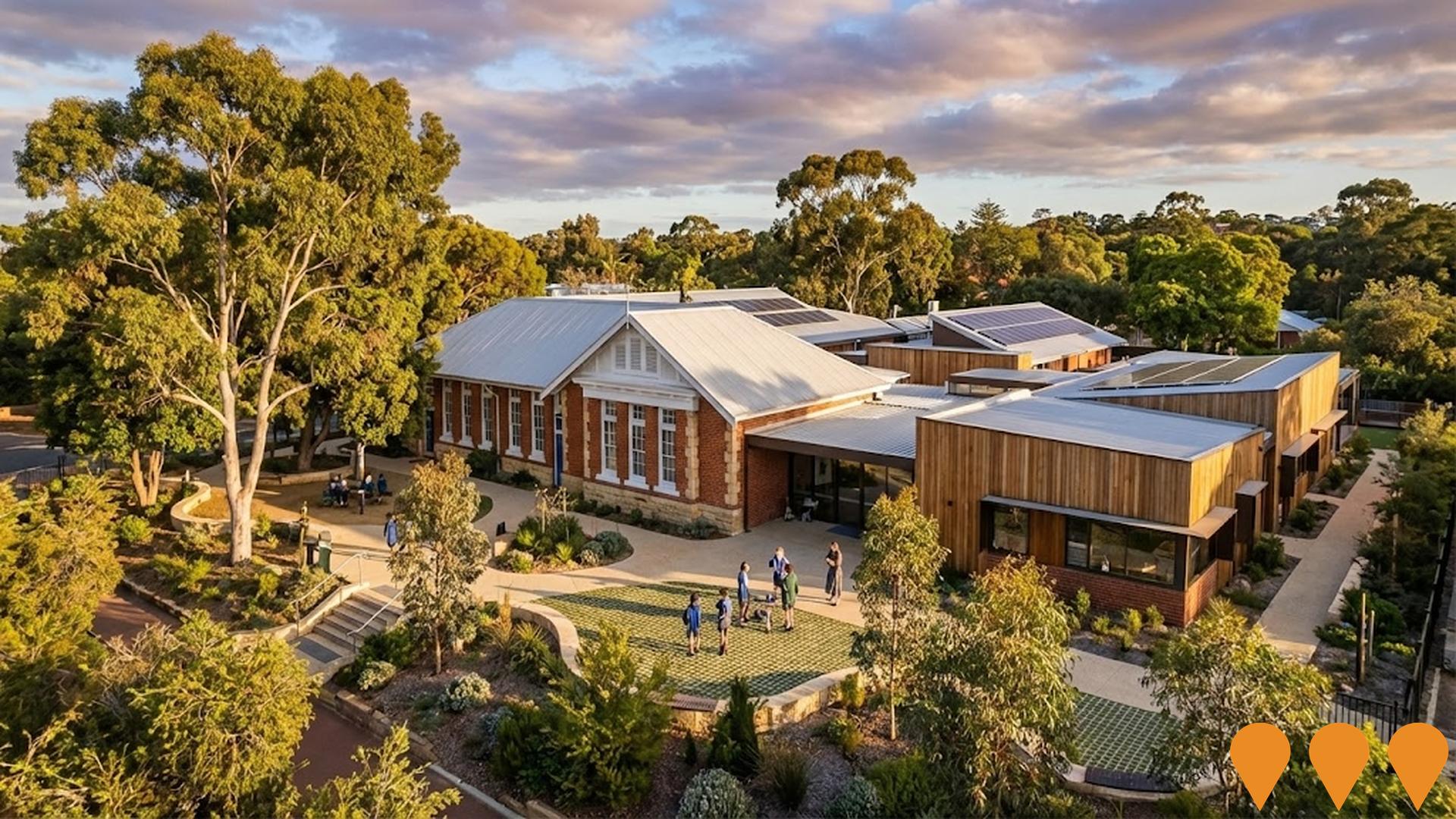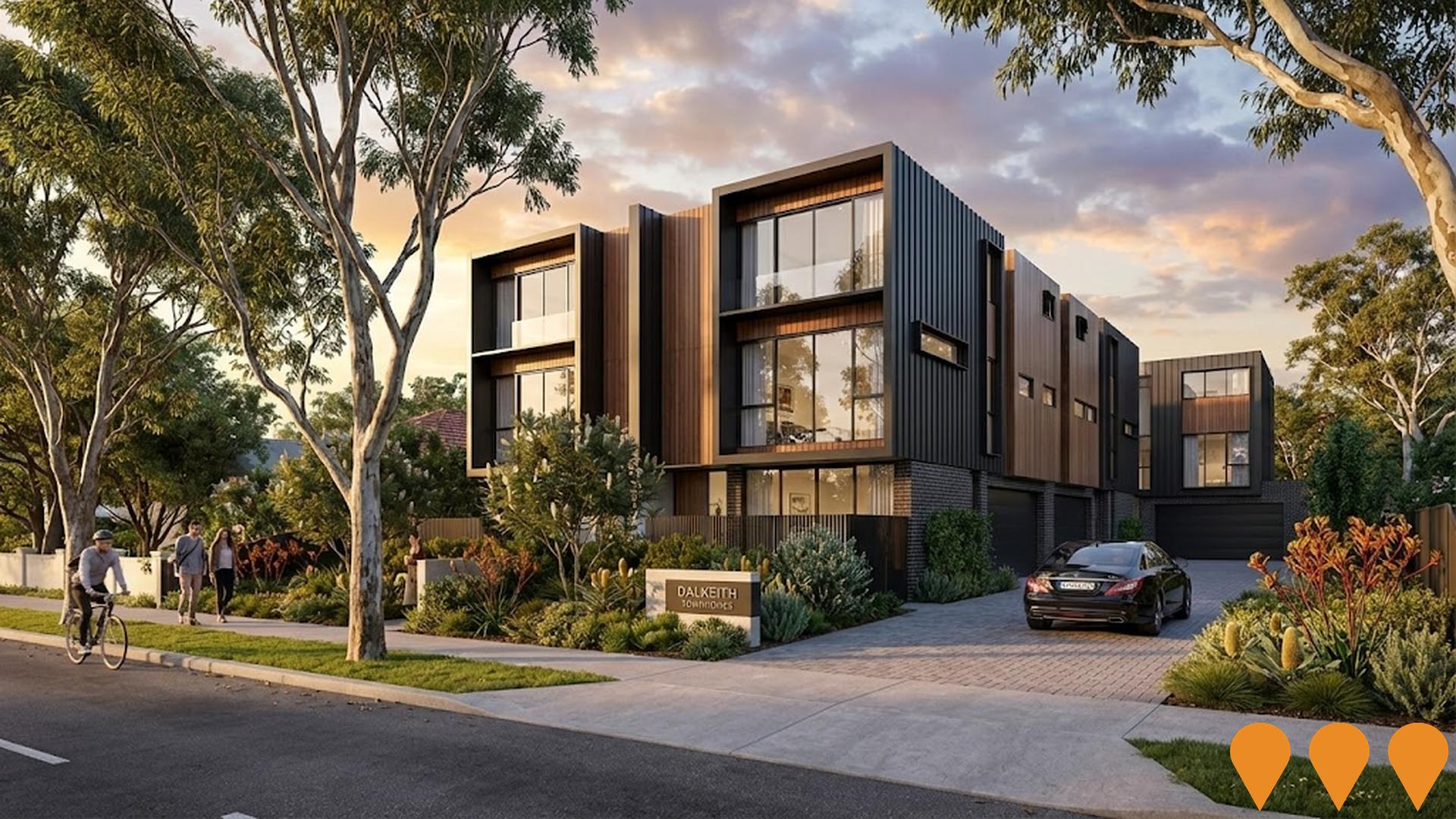Chart Color Schemes
est. as @ -- *
ABS ERP | -- people | --
2021 Census | -- people
Sales Activity
Curious about local property values? Filter the chart to assess the volume and appreciation (including resales) trends and regional comparisons, or scroll to the map below view this information at an individual property level.
Find a Recent Sale
Sales Detail
Population
An assessment of population growth drivers in Nedlands - Dalkeith - Crawley reveals an overall ranking slightly below national averages considering recent, and medium term trends
Nedlands - Dalkeith - Crawley's population was approximately 21,985 as of Aug 2025. This figure reflects an increase of 3,049 people since the 2021 Census, which reported a population of 18,936. The growth is inferred from ABS estimates: 21,741 in June 2024 and an additional 200 validated new addresses since the Census date. This results in a density ratio of 2,254 persons per square kilometer, above national averages assessed by AreaSearch. The area's growth rate of 16.1% since the 2021 census exceeded the national average of 8.6%. Population growth was primarily driven by overseas migration.
AreaSearch adopts ABS/Geoscience Australia projections for each SA2 area, released in 2024 with a base year of 2022. For areas not covered, AreaSearch uses ABS Greater Capital Region projections released in 2023 based on 2022 data. Projected demographic shifts indicate above median population growth nationally, with the area expected to grow by 3,074 persons to 2041, recording a gain of 12.9% over 17 years.
Frequently Asked Questions - Population
Development
The level of residential development activity in Nedlands - Dalkeith - Crawley was found to be higher than 90% of real estate markets across the country
Nedlands - Dalkeith - Crawley has recorded approximately 156 residential properties granted approval annually. Over the past five financial years, from FY21 to FY25, around 784 homes were approved, with an additional 28 approved so far in FY26. On average, each dwelling has accommodated about 2.7 new residents per year over these five years, reflecting strong demand that supports property values.
New homes are being built at an average expected construction cost of $906,000, indicating a focus on the premium segment with upmarket properties. This financial year has seen around $140.8 million in commercial approvals, suggesting robust commercial development momentum. Compared to Greater Perth, Nedlands - Dalkeith - Crawley exhibits moderately higher development activity, at 47.0% above the regional average per person over the five-year period, offering good buyer choice while supporting existing property values. The new development consists of approximately 34.0% standalone homes and 66.0% attached dwellings, reflecting a trend towards denser development to provide accessible entry options for downsizers, investors, and entry-level buyers. This shift contrasts with the area's current housing composition, which is predominantly houses at around 68.0%.
At approximately 186 people per approval, Nedlands - Dalkeith - Crawley reflects a developing area. Population forecasts indicate that the area will gain around 2,830 residents by 2041. Given current development rates, new housing supply is expected to comfortably meet demand, providing good conditions for buyers and potentially supporting growth beyond current population projections.
Frequently Asked Questions - Development
Infrastructure
Nedlands - Dalkeith - Crawley has limited levels of nearby infrastructure activity, ranking in the 8thth percentile nationally
Changes in local infrastructure significantly affect an area's performance. AreaSearch has identified 27 projects that could impact this region. Notable projects are Nedlands Square, Bloom Residences, Fremantle Line Upgrades, and ALDI Nedlands. The following details projects likely to be most relevant.
Professional plan users can use the search below to filter and access additional projects.
INFRASTRUCTURE SEARCH
 Denotes AI-based impression for illustrative purposes only, not to be taken as definitive under any circumstances. Please follow links and conduct other investigations from the project's source for actual imagery. Developers and project owners wishing us to use original imagery please Contact Us and we will do so.
Denotes AI-based impression for illustrative purposes only, not to be taken as definitive under any circumstances. Please follow links and conduct other investigations from the project's source for actual imagery. Developers and project owners wishing us to use original imagery please Contact Us and we will do so.
Frequently Asked Questions - Infrastructure
Nedlands Square
Redevelopment of the Captain Stirling Hotel precinct into a new town centre anchored by a full line Woolworths supermarket with 28 specialty stores, food and beverage tenancies, wellness and medical services, a community square, 368 on site car parks, and restoration of the heritage listed Captain Stirling Hotel. The project is underway and is scheduled to open in late 2026.

ALDI Nedlands
Redevelopment of the former Captain Stirling Centre into a new ALDI supermarket with six smaller tenancies, a rear laneway and semi-basement parking. State DAP approval granted on 11 Feb 2025; construction expected to follow with opening targeted for 2026.

Nedlands Masterplan Project
UWA is preparing a masterplan to guide the future use of the Nedlands campus (Lot 8235 Gordon St), aligning with a forthcoming State-led Improvement Plan and Scheme for the UWA-QEII precinct. A separate student accommodation project on the north east corner of the site was approved by the Western Australian Planning Commission in February 2025; broader site planning remains underway through 2025-26 with the masterplan intended to inform the State Improvement Scheme.
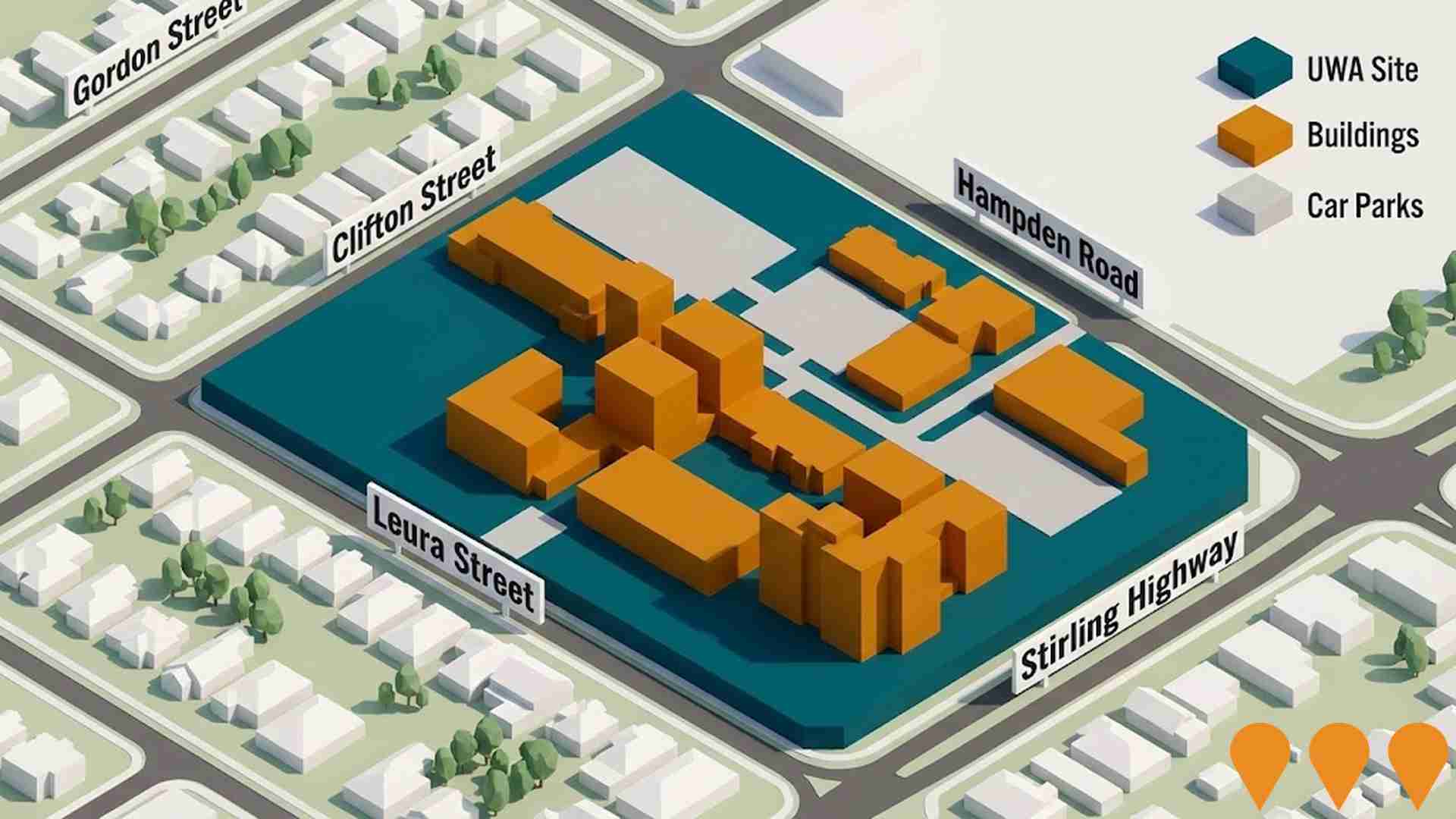
Nedlands Reserve (Nedlands Village Precinct)
7.4ha master-planned mixed-use precinct led by Human Urban (H-U) with a WAPC-approved Precinct Structure Plan (SPN 2379, Feb 2025). The plan provides for around 500 dwellings (townhouses and apartments), approx. 15,900sqm GFA of mixed-use/medical floorspace along Monash Ave, retention of the existing aged care facility, a central park (0.6ha), permeable street network and design guidelines for staged delivery.
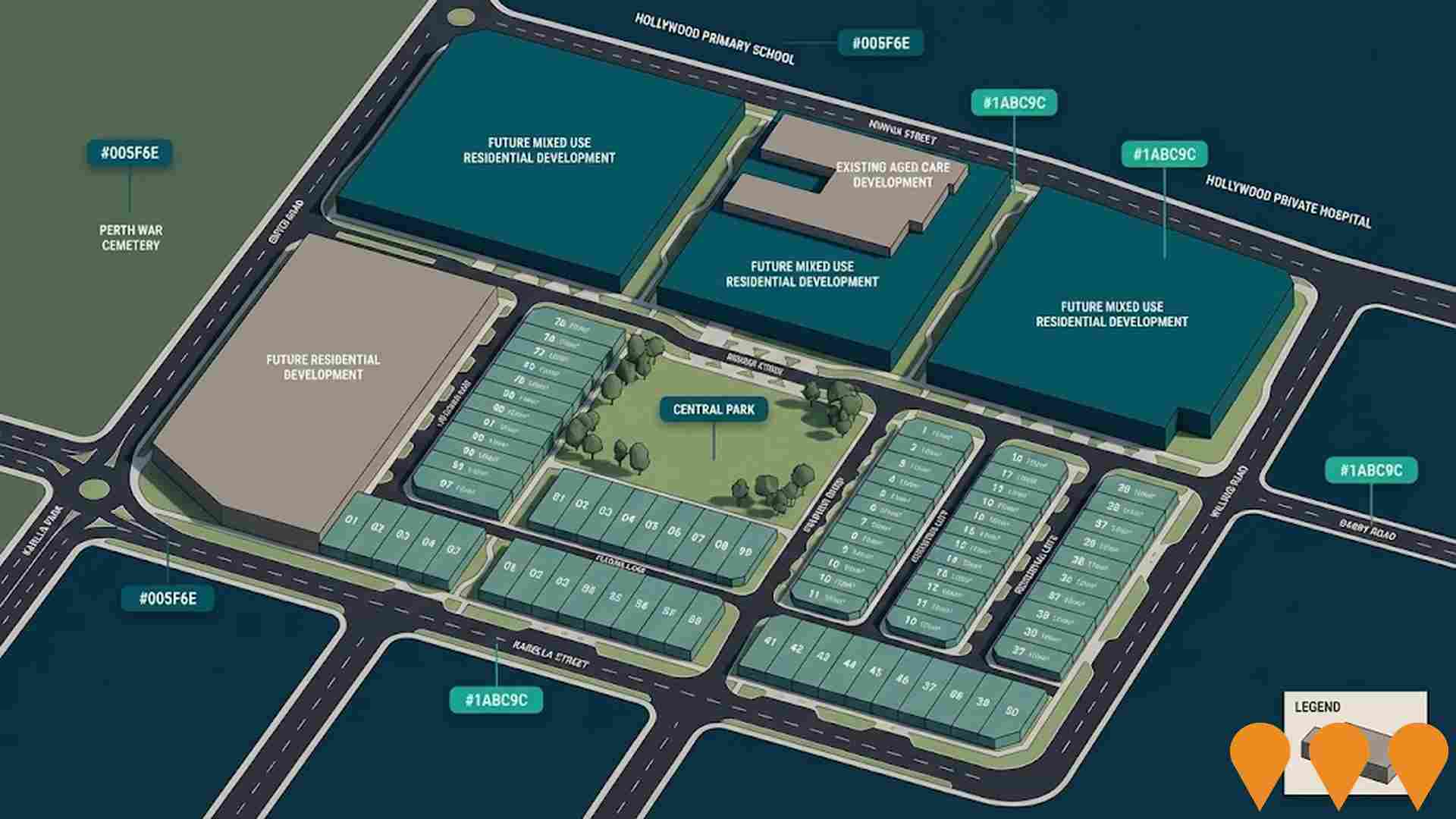
Broadway on the Bay
A boutique riverside development of 21 luxury apartments over 8 levels in Crawley, offering uninterrupted parkland and Swan River views. The project is developed by Edge Visionary Living, a premium and award-winning apartment developer in WA. Designed by Hillam Architects with Art Deco influences, located opposite iconic Steve's Hotel with direct river access. Located adjacent to JH Abrahams Reserve with panoramic views of the Swan River and Perth city skyline. Features luxury resident amenities including wellness garden, outdoor terrace, gym, sauna, quiet lounge and dining room. Completion scheduled for Q3 2025.
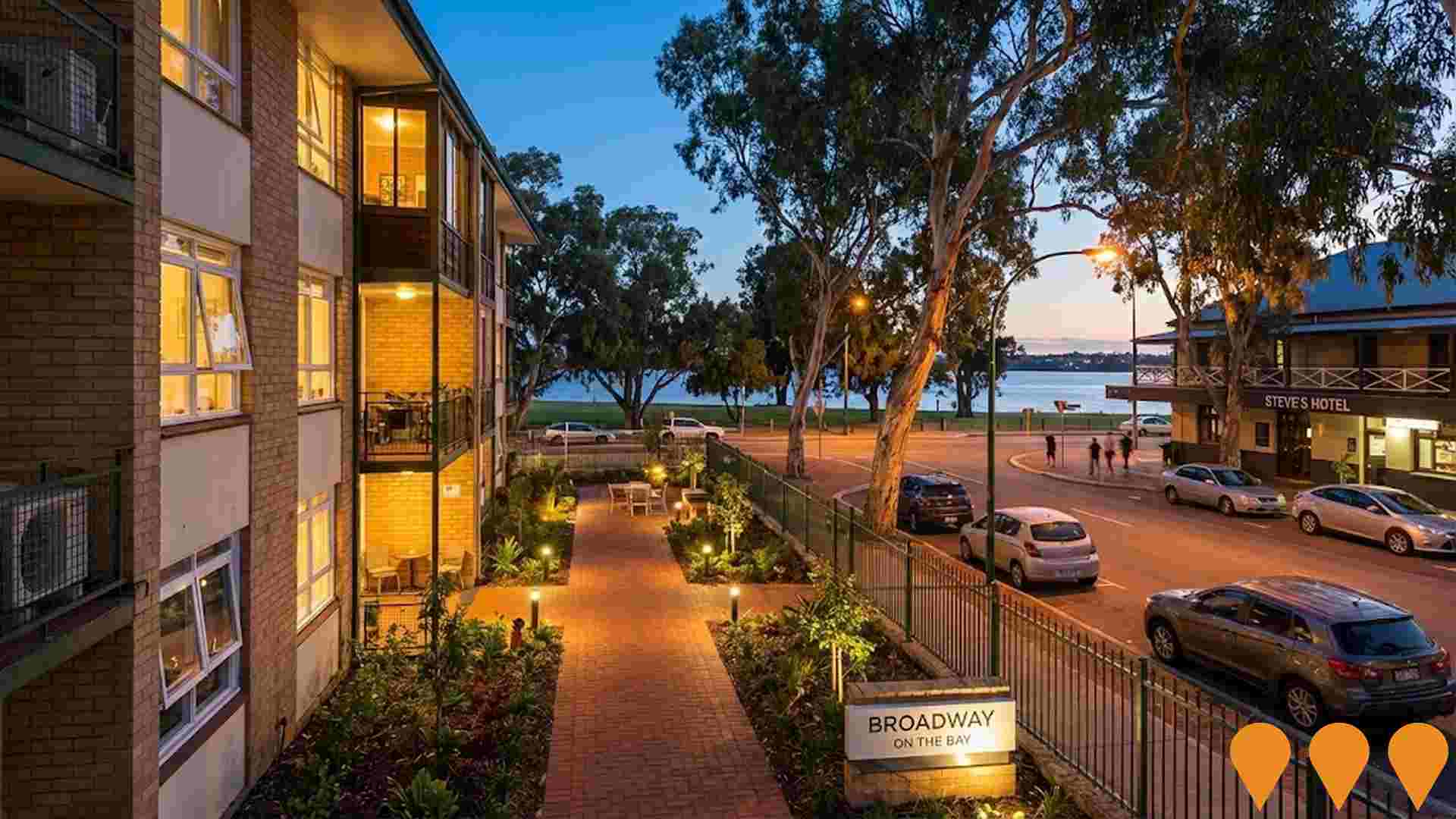
Numa
Major mixed-use development featuring 275 high-end apartments across three towers (18-24 storeys) plus over 3,500sqm of commercial, retail and entertainment space. Includes town square and public realm areas.
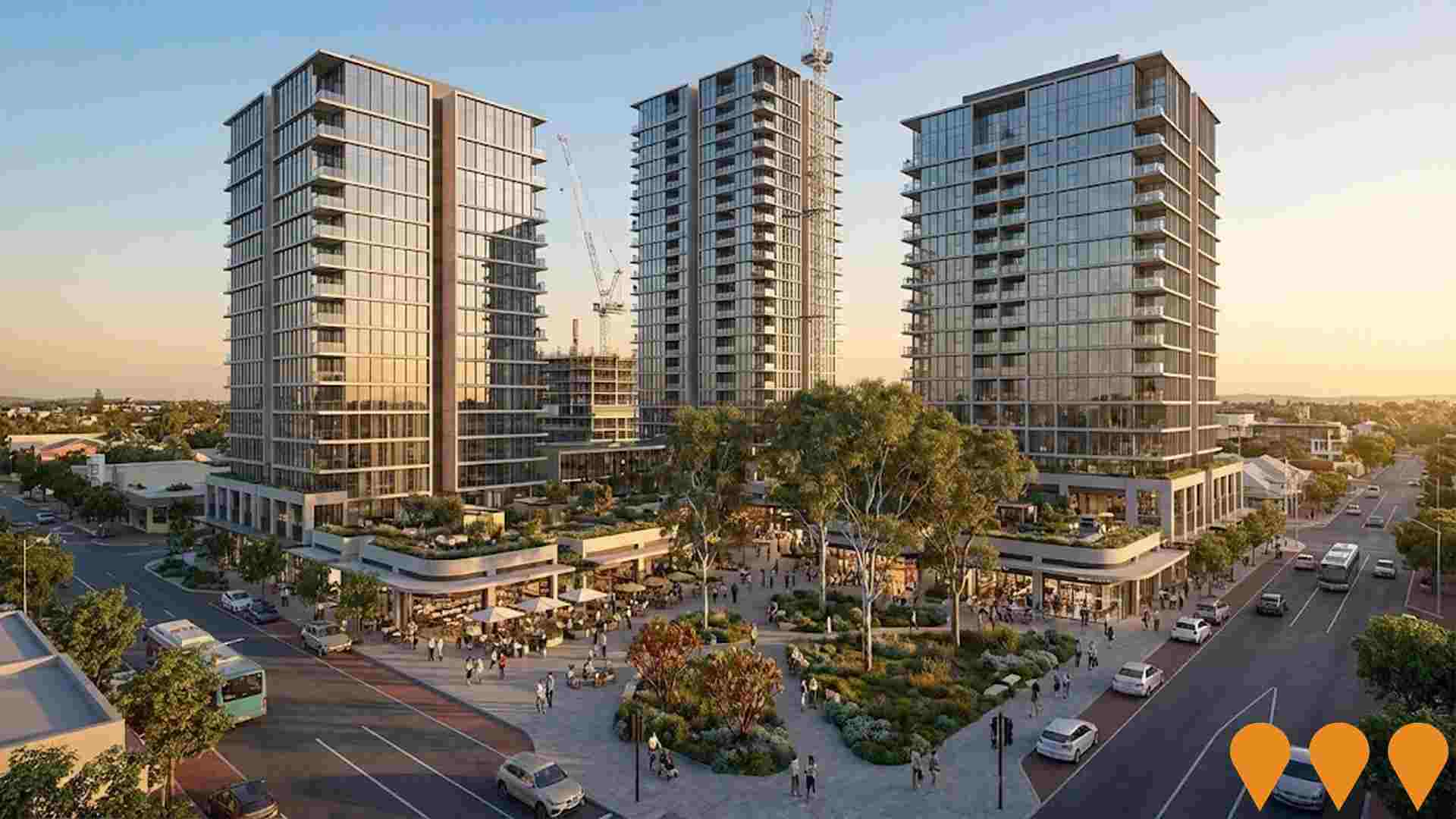
QEII Medical Centre Expansion
Major expansion of medical facilities at QEII including new clinical buildings, research facilities, and enhanced patient services infrastructure to support the medical precinct.
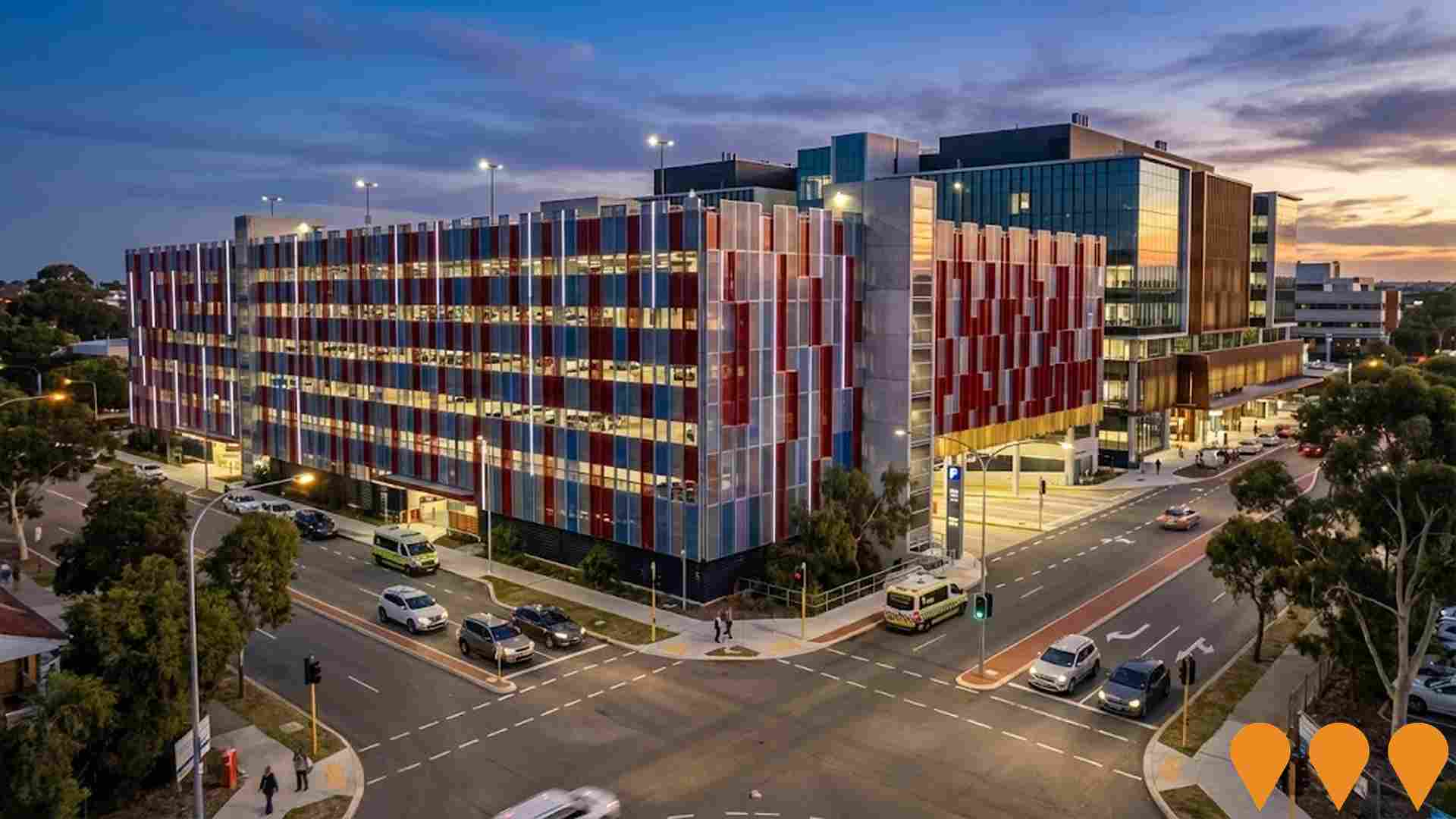
Fremantle Line Upgrades
Major railway infrastructure upgrades including new signaling systems, platform improvements, and accessibility enhancements at Nedlands Station as part of broader Fremantle Line improvements.
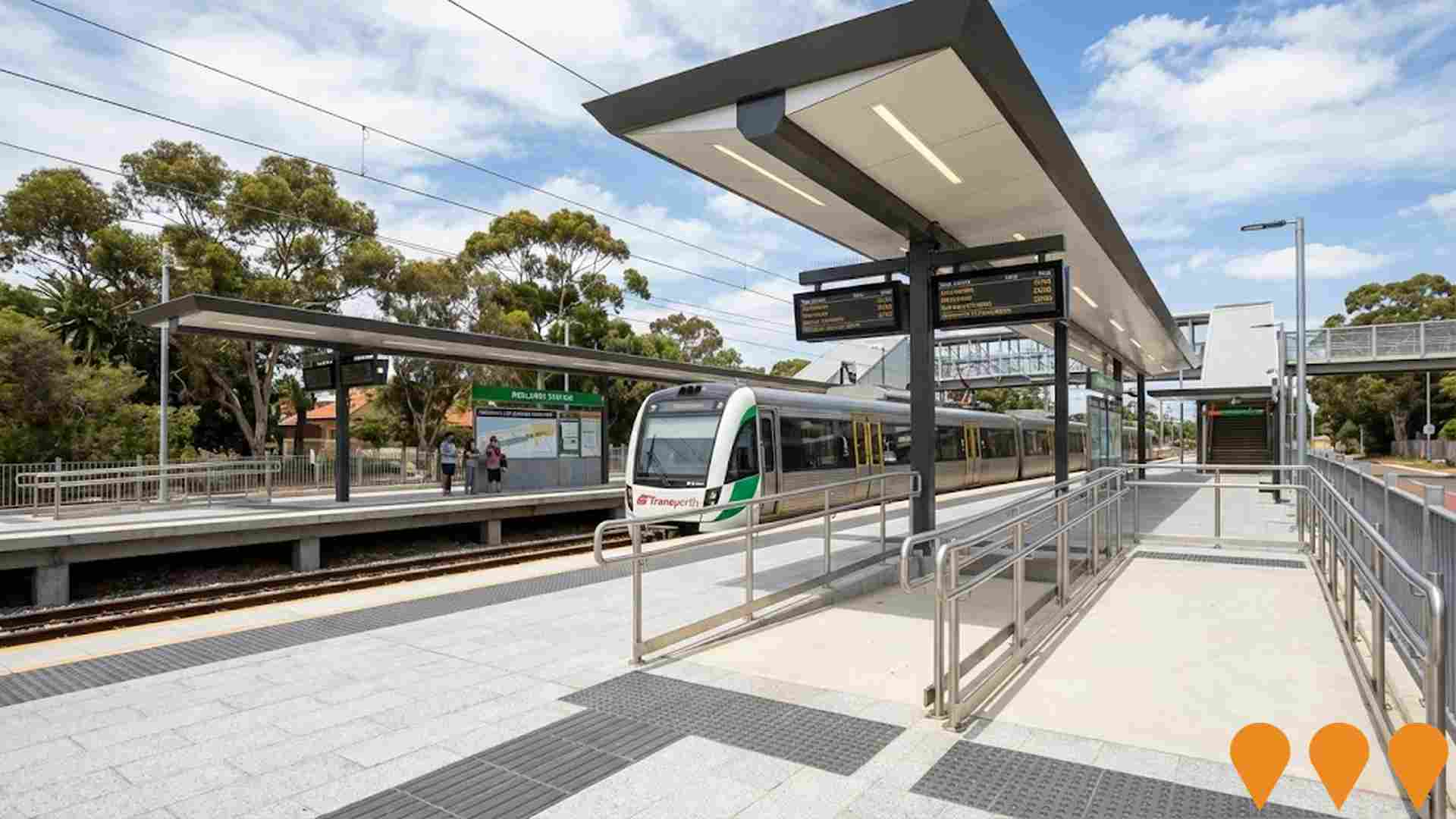
Employment
Employment conditions in Nedlands - Dalkeith - Crawley demonstrate exceptional strength compared to most Australian markets
Nedlands-Dalkeith-Crawley has a highly educated workforce with professional services being strongly represented. The unemployment rate in June 2025 was 1.5%.
There were 11,513 residents employed at this time, with an unemployment rate of 2.3% below Greater Perth's rate of 3.9%. Workforce participation was somewhat lower than the Greater Perth average (60.9% compared to 65.2%). Employment is concentrated in health care & social assistance, professional & technical services, and education & training. Notably, health care & social assistance employment levels are at 1.5 times the regional average.
Conversely, construction shows lower representation at 3.9% versus the regional average of 9.3%. The area functions as an employment hub with 1.3 workers for every resident, attracting workers from surrounding areas. Over the 12 months to June 2025, labour force levels decreased by 1.4%, while employment declined by 1.7%, causing the unemployment rate to rise by 0.3 percentage points. This compares to Greater Perth where employment grew by 3.7%. Jobs and Skills Australia's national employment forecasts from May 2025 suggest that Nedlands-Dalkeith-Crawley's employment could grow by approximately 7.6% over five years and 15.4% over ten years, based on a simple weighting extrapolation of industry-specific projections against the local employment mix.
Frequently Asked Questions - Employment
Income
Income metrics indicate excellent economic conditions, with the area achieving higher performance than 75% of national locations assessed by AreaSearch
AreaSearch's aggregation of ATO data shows Nedlands - Dalkeith - Crawley had a median taxpayer income of $64,919 and an average of $175,737 in financial year 2022. These figures place it among the top percentile nationally, compared to Greater Perth's $58,380 and $78,020 respectively. By September 2025, adjusted for Wage Price Index growth of 14.2%, estimated median income is approximately $74,137 and average is $200,692. The 2021 Census ranks household incomes at the 93rd percentile with a weekly amount of $2,610. In this area, 38.0% of individuals earn over $4,000 weekly, contrasting with the region's leading bracket of $1,500 - 2,999 at 32.0%. With 46.3% earning over $3,000 weekly, it supports premium retail and services. After housing costs, residents retain 86.9% of income. The area's SEIFA income ranking is in the 9th decile.
Frequently Asked Questions - Income
Housing
Nedlands - Dalkeith - Crawley displays a diverse mix of dwelling types, with above-average rates of outright home ownership
In Nedlands-Dalkeith-Crawley, as per the latest Census, 67.5% of dwellings were houses, with 32.5% being other types such as semi-detached homes, apartments, and 'other' dwellings. This compares to Perth metro's 68.6% houses and 31.4% other dwellings. Home ownership in the area was 44.1%, similar to Perth metro, with mortgaged dwellings at 24.6% and rented ones at 31.3%. The median monthly mortgage repayment was $3,521, above Perth metro's average of $3,293. Weekly rent median was $450, the same as Perth metro's figure. Nationally, Nedlands-Dalkeith-Crawley's mortgage repayments were higher than the Australian average of $1,863, and rents were substantially above the national figure of $375.
Frequently Asked Questions - Housing
Household Composition
Nedlands - Dalkeith - Crawley features high concentrations of group households, with a fairly typical median household size
Family households comprise 71.8% of all households, including 35.8% couples with children, 28.2% couples without children, and 6.6% single parent families. Non-family households account for the remaining 28.2%, with lone person households at 21.9% and group households comprising 6.3%. The median household size is 2.6 people, which matches the Greater Perth average.
Frequently Asked Questions - Households
Local Schools & Education
Nedlands - Dalkeith - Crawley shows strong educational performance, ranking in the upper quartile nationally when assessed across multiple qualification and achievement indicators
Educational attainment in Nedlands-Dalkeith-Crawley is significantly higher than broader benchmarks. 61.0% of residents aged 15 and above hold university qualifications, compared to 27.9% in Western Australia and 30.1% in Greater Perth. Bachelor degrees are the most common at 36.3%, followed by postgraduate qualifications (20.1%) and graduate diplomas (4.6%). Technical qualifications represent 13.5% of educational achievements, with advanced diplomas at 7.4% and certificates at 6.1%.
Educational participation is high, with 40.4% of residents currently enrolled in formal education. This includes 19.9% in tertiary education, 8.8% in primary education, and 8.2% pursuing secondary education. The five schools in the area have a combined enrollment of 1,229 students, with an ICSEA score of 1179, indicating high educational performance nationally. There are four primary schools and one K-12 school. School capacity is limited at 5.6 places per 100 residents compared to the regional average of 18.1, leading many families to travel for schooling. Note: where school enrolments show 'n/a', please refer to the parent campus.
Frequently Asked Questions - Education
Schools Detail
Nearby Services & Amenities
Transport
Transport servicing is good compared to other areas nationally based on assessment of service frequency, route connectivity and accessibility
Nedlands-Dalkeith-Crawley area has 151 active public transport stops. These are served by 17 bus routes, offering a total of 5,224 weekly passenger trips. Residential accessibility to these stops is rated excellent, with an average distance of 167 meters from the nearest stop.
The service frequency across all routes averages 746 trips per day, equating to about 34 weekly trips per individual stop.
Frequently Asked Questions - Transport
Transport Stops Detail
Health
Nedlands - Dalkeith - Crawley's residents boast exceedingly positive health performance metrics with very low prevalence of common health conditions across all age groups
Health outcomes data shows excellent results across Nedlands-Dalkeith-Crawley with very low prevalence of common health conditions across all age groups. The rate of private health cover is exceptionally high at approximately 91% of the total population (20,050 people), compared to 87.5% across Greater Perth and a national average of 55.3%. Mental health issues and asthma were found to be the most common medical conditions in the area, impacting 6.7 and 6.3% of residents respectively, while 74.2% declared themselves completely clear of medical ailments, similar to the 74.2% across Greater Perth.
The area has 18.8% of residents aged 65 and over (4,126 people), lower than the 21.5% in Greater Perth. Health outcomes among seniors are particularly strong, performing even better than the general population in health metrics.
Frequently Asked Questions - Health
Cultural Diversity
Nedlands - Dalkeith - Crawley is among the most culturally diverse areas in the country based on AreaSearch assessment of a range of language and cultural background related metrics
Nedlands-Dalkeith-Crawley has high cultural diversity, with 23.1% speaking a language other than English at home and 40.2% born overseas. Christianity is the main religion, comprising 45.7%. Judaism, at 0.6%, is slightly higher than Greater Perth's average of 0.5%.
Top ancestral groups are English (24.9%), Australian (19.8%), and Chinese (11.5%), significantly higher than regional averages. South African (0.9%) and Sri Lankan (0.6%) are overrepresented, while French remains at the regional average of 0.7%.
Frequently Asked Questions - Diversity
Age
Nedlands - Dalkeith - Crawley's population is slightly younger than the national pattern
Nedlands-Dalkeith-Crawley has a median age of 36 years, nearly matching Greater Perth's average of 37 years, which is slightly below the Australian median of 38 years. Compared to Greater Perth, Nedlands-Dalkeith-Crawley has a higher proportion of residents aged 15-24 (25.9%) but fewer residents aged 35-44 (9.4%). This concentration of 15-24 year-olds is significantly higher than the national average of 12.5%. Between the 2016 and 2021 censuses, younger residents have shifted the median age down by 1.4 years to 36 years. Key demographic changes include an increase in the 15-24 age group from 21.0% to 25.9%, and a growth in the 25-34 cohort from 10.6% to 11.9%. Conversely, the 65-74 age group has decreased from 10.4% to 8.8%, and the 35-44 age group has dropped from 10.7% to 9.4%. Population forecasts for 2041 indicate substantial demographic changes for Nedlands-Dalkeith-Crawley, with the 85+ age cohort projected to grow exceptionally, increasing by 864 people (149%) from 580 to 1,445. Notably, the combined 65+ age groups will account for 53% of total population growth, reflecting the area's aging demographic profile. Meanwhile, both the 35-44 and 5-14 age groups are expected to see reduced numbers.
